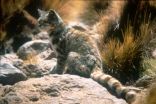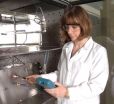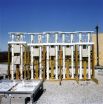(Press-News.org) Once thought to exclusively inhabit its namesake mountain range, the threatened Andean cat—a house cat-sized feline that resembles a small snow leopard in both appearance and habitat—also frequents the Patagonian steppe at much lower elevations, according to a new study published by the Wildlife Conservation Society and partners.
The finding represents a range extension for the Andean cat, which normally occurs at altitudes above 3,000 meters (approximately 9,800 feet). The new survey presents evidence of the cats occurring at elevations as low as 650 meters (approximately 2,100 feet) on the Patagonian steppe. The species is listed as "Endangered" on the World Conservation Union's Red List and may number only 2,500 individuals throughout its entire range.
The study appears in the recent edition of CATNews. The authors include: Andres Novaro and Lorena Rivas of the Wildlife Conservation Society and CONICET, Argentina; Susan Walker of the Wildlife Conservation Society; Rocio Palacios of Alianza Gato Andino; Sebastian di Martino of Department of Protected Areas of the Province of Neuquén; Martin Monteverde of Centro de Ecología Aplicada del Neuquén; Sebastian Canadell of Universidad Nacional de Cordoba; and Daniel Cossios of Université de Montréal.
"These confirmed records show the lowest elevations ever reported for the Andean cat," said WCS conservationist Andres Novaro, lead author of the study. "According to genetic studies underway led by Daniel Cossios, this new population appears to represent an evolutionary lineage distinct from the highland population."
Prompted by a lone photograph of two Andean cats in the foothills of central Argentina, the research team surveyed approximately 31,000 square kilometers (approximately 12,000 square miles) of Argentina's Mendoza and Neuquén provinces in 2007-2009. The team collected samples from several locations that included scat, skulls, and skin, all of which were confirmed with DNA analysis. In addition, the researchers conducted surveys with inhabitants of the region. The conservationists also found evidence of three other small cat species: Geoffroy's cat, pampas cat, and jaguarundi.
The Andean cat's range extension coincides with the known distribution of the mountain vizcacha, a rabbit-like rodent that inhabits both the Andes Mountains and Patagonian steppe and is the Andean cat's primary prey.
"Discovering a new population of Andean cats is an important finding for this elusive and rare species," said Mariana Varese, Acting Director of WCS's Latin America and Caribbean Program. "Determining the range of the Andean cat in the Patagonian steppe will provide conservationists with a foundation for later conservation plans."
Threats to the newly discovered population of Andean cat include goat herders who assume the felines are preying on their livestock, oil exploration activities that destroy habitat, and new roads that open up formerly inaccessible areas to poachers.
INFORMATION:
Critical support for this study was provided by Panthera, the Rufford Small Grants Foundation, Wildlife Conservation Network, and the Whitley Fund for Nature. WCS is grateful to the following for their partnership: the Department of Renewable Natural Resources of Mendoza and the Department of Protected Areas of Neuquén provinces.
WCS's programs and activities in the region are generously supported by the Butler Conservation Fund and the Liz Claiborne and Art Ortenberg Foundation.
Rare Andean cat no longer exclusive to the Andes
Wildlife Conservation Society and partners find endangered cat species beyond the mountains in Patagonian steppe
2011-03-18
ELSE PRESS RELEASES FROM THIS DATE:
Paleontologists audition modern examples of ancient behavior
2011-03-18
Paleontologists agree that it's difficult to observe behavior in fossil specimens that are dead – even extinct – and petrified. One method is to find a modern, living, species that has some similarities to the ancient animal.
That's the strategy adopted by David L. Meyer, University of Cincinnati professor of geology and colleagues as they study a group of ancient shellfish known as brachiopods. Although they resemble clams or other shelled mollusks, brachiopods are more closely related to marine worms. Relatively rare today, brachiopods were a dominant species in Paleozoic ...
Pardee Homes' Manzanita Trail in Coastal-close North San Diego County Offers Options for Downsizing
2011-03-18
Home shoppers who want the bigger bedroom count, but not the responsibilities of a big yard, have two great choices at Pardee Homes' Manzanita Trail in Pacific Highlands Ranch. The classic front porch designed Plan 1 and Plan 2 homes each have four bedrooms and very manageable side courtyards that help free the homeowner from yard work. Residents at Manzanita Trail also enjoy all the benefits of living within walking distance to the private Pacific Highlands Ranch Recreation Center.
Families like the McSherrys, who have four children, were thrilled to downsize from their ...
Breaking the mucus barrier unveils cancer cell secrets
2011-03-18
Washington, D.C. (March 16, 2011) -- Measuring the mechanical strength of cancer cell mucus layers provides clues about better ways to treat cancer, and also suggests why some cancer cells are more resistant to drugs than others, according to Kai-tak Wan, associate professor of engineering at Northeastern University, Boston, Mass.
According to Wan, healthy tissues naturally secrete mucus to protect against infection. Cancer cells, however, produce far more mucus than healthy cells.
Mucus consists of protein "stalks" attached to sugar sidechains, or "branches." This ...
Bacterial wipes research study
2011-03-18
(Edmonton) If you have time to quickly swipe your pager or cell phone three times, that would be your best bet to get rid of most of the bacteria. And a simple tissue moistened with saline would do the trick. But if you only have time for a single swipe of a 'dirty' phone – you'd be better off reaching for a disinfectant wipe.
Those are the highlights of a recently published research study that appeared online in PubMed, with the discoveries having been made by a team of researchers in the Faculty of Medicine & Dentistry at the University of Alberta.
"It was the mechanical ...
Fossils record ancient migrations and trilobite orgies
2011-03-18
Few specimens inspire greater thrills among fossil collectors than a complete trilobite. These ancient arthropods – relatives of lobsters, spiders and insects – went extinct more than 250 million years ago, but are sometimes found in beautifully preserved condition. In rare instances, an entire population of trilobites is found fossilized together. Carlton E. Brett finds evidence for ancient environment and behavior in these mass graves.
Brett, University of Cincinnati professor of geology, will present his findings March 20 at the Geological Society of America regional ...
New tool debuts for measuring indoor air pollutants
2011-03-18
A promising new approach for checking the accuracy of measurements of hazardous indoor air pollutants may soon be ready for prime time, report researchers from the National Institute of Standards and Technology (NIST) and Virginia Tech.* The measurement tool, a reference sample for volatile organic compounds (VOCs), would be a boon to testers of indoor air quality and to manufacturers of paints, rugs, cleaners and other building products.
The researchers put their innovation—thin squares of plastic saturated with vapors of a common solvent—through the paces at four testing ...
New NIST testing device may help to 'seal the deal' for building owners
2011-03-18
Just as a chain is as strong as its weakest link, a building is as secure against the environment as its most degraded joint sealants, about 50 percent of which fail in less than 10 years after installation.
The upshot for U.S. homeowners is that moisture damage due to failed sealants is responsible for much of the $65 billion to $80 billion they collectively shell out for house repairs annually.
Researchers at the National Institute of Standards and Technology (NIST) are assembling a toolkit of measurement devices and scientific data that will help manufacturers of ...
Study shows attendance at state parks grows, even as funding decreases
2011-03-18
A recent study from North Carolina State University shows that while the number of visits to state parks across the country has grown, fund support for park operations has been significantly reduced. The reduction in funding during a time of park growth endangers the more than $20 billion in economic impact that state parks have on the nation's economy.
"Obviously the reduction in general-fund support for operations puts stress on America's state-park systems," says Dr. Yu-Fai Leung, NC State associate professor of recreation ecology, park planning and visitor management, ...
3 in 4 domestic violence victims go unidentified in emergency rooms, Penn study shows
2011-03-18
PHILADELPHIA -- More than three quarters of domestic violence victims who report the incidents to police seek health care in emergency rooms, but most of them are never identified as being victims of abuse during their hospital visit. These findings, from a new University of Pennsylvania School of Medicine study, point to a missed opportunity to intervene and offer help to women who suffer violence at the hands of an intimate partner.
"Emergency departments are a safety net for women with health issues of all kinds, but our study shows we're not doing a good enough job ...
New findings on the developments of the earthquake disaster
2011-03-18
16.03.2011 | Potsdam: The earthquake disaster on 11 March 2011 was an event of the century not only for Japan. With a magnitude of Mw = 8.9, it was one of the strongest earthquakes ever recorded worldwide. Particularly interesting is that here, two days before, a strong foreshock with a magnitude Mw = 7.2 took place almost exactly at the breaking point of the tsunami-earthquake. The geophysicist Joachim Saul from the GFZ German Research Centre for Geosciences (Helmholtz Association) created an animation which shows the sequence of quakes since March 9.
The animated image ...
LAST 30 PRESS RELEASES:
Injectable breast ‘implant’ offers alternative to traditional surgeries
Neuroscientists devise formulas to measure multilingualism
New prostate cancer trial seeks to reduce toxicity without sacrificing efficacy
Geometry shapes life
A CRISPR screen reveals many previously unrecognized genes required for brain development and a new neurodevelopmental disorder
Hot flush treatment has anti-breast cancer activity, study finds
Securing AI systems against growing cybersecurity threats
Longest observation of an active solar region
Why nail-biting, procrastination and other self-sabotaging behaviors are rooted in survival instincts
Regional variations in mechanical properties of porcine leptomeninges
Artificial empathy in therapy and healthcare: advancements in interpersonal interaction technologies
Why some brains switch gears more efficiently than others
UVA’s Jundong Li wins ICDM’S 2025 Tao Li Award for data mining, machine learning
UVA’s low-power, high-performance computer power player Mircea Stan earns National Academy of Inventors fellowship
Not playing by the rules: USU researcher explores filamentous algae dynamics in rivers
Do our body clocks influence our risk of dementia?
Anthropologists offer new evidence of bipedalism in long-debated fossil discovery
Safer receipt paper from wood
Dosage-sensitive genes suggest no whole-genome duplications in ancestral angiosperm
First ancient human herpesvirus genomes document their deep history with humans
Why Some Bacteria Survive Antibiotics and How to Stop Them - New study reveals that bacteria can survive antibiotic treatment through two fundamentally different “shutdown modes”
UCLA study links scar healing to dangerous placenta condition
CHANGE-seq-BE finds off-target changes in the genome from base editors
The Journal of Nuclear Medicine Ahead-of-Print Tip Sheet: January 2, 2026
Delayed or absent first dose of measles, mumps, and rubella vaccination
Trends in US preterm birth rates by household income and race and ethnicity
Study identifies potential biomarker linked to progression and brain inflammation in multiple sclerosis
Many mothers in Norway do not show up for postnatal check-ups
Researchers want to find out why quick clay is so unstable
Superradiant spins show teamwork at the quantum scale
[Press-News.org] Rare Andean cat no longer exclusive to the AndesWildlife Conservation Society and partners find endangered cat species beyond the mountains in Patagonian steppe



